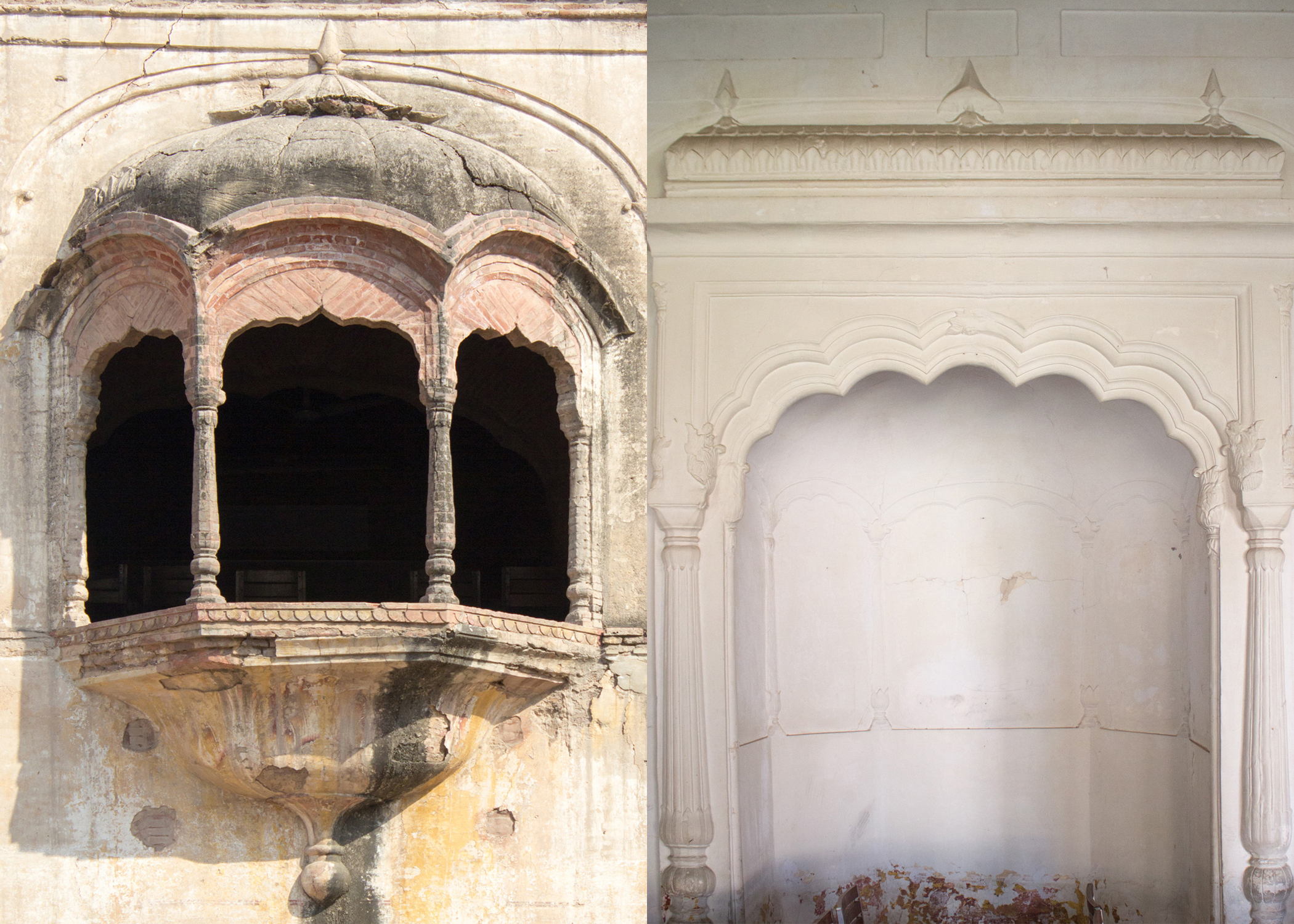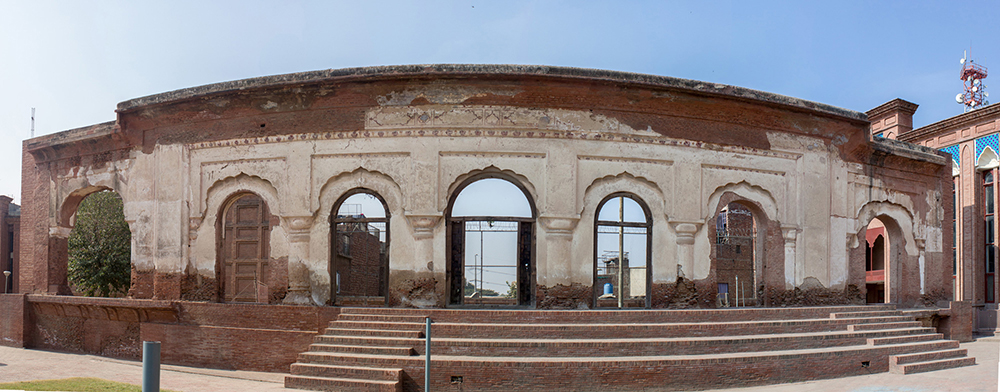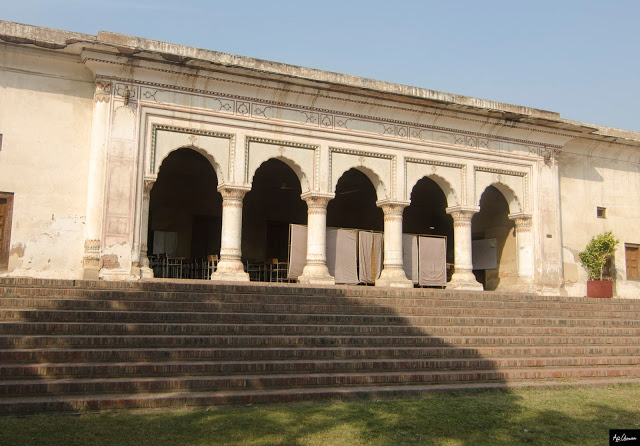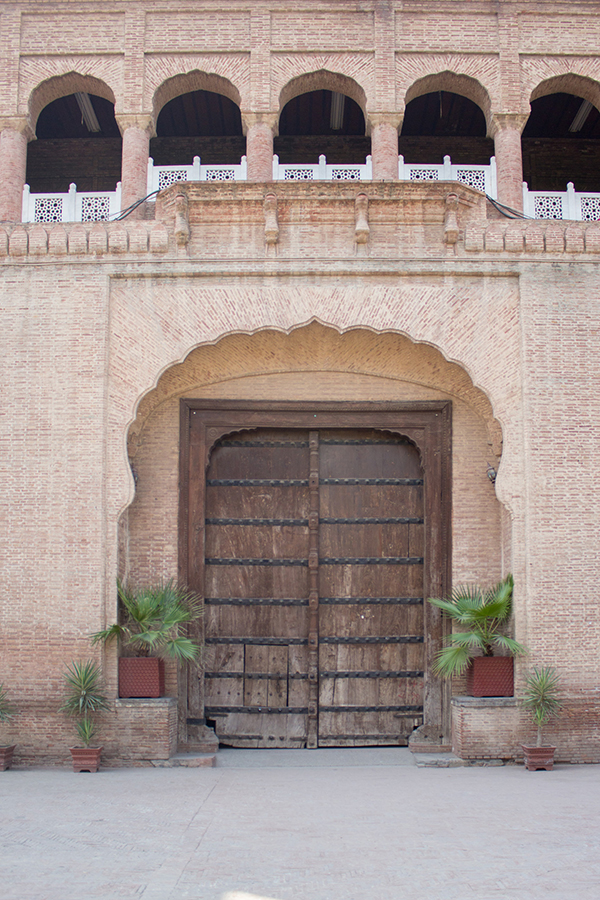Written by: Mahnoor Fatima
Posted on: December 18, 2020 |  | 中文
| 中文
Sikh Designs on the Haveli (photo credits to Awais Jibran)
The Walled City of Lahore is not just comprised of grand monuments that hark back to the glory of bygone rulers. Deep within its intricate streets and busy roads are stories of people and communities which went through great change and transformation. Haveli Dhyan Singh is one such compound with a history that spans generations, weaving its residents in a complex net of historical circumstances. It is part of a large, dazzling compound known colloquially as ‘Chunna Mandi’, the neighborhood with the oldest havelis in the city. A Haveli is a mansion or townhouse special to the Indian Subcontinent, known for their intricate designs and vast courtyards.
Haveli Dhyan Singh (or Haveli Asif Jah) has a particularly rich legacy, starting from the Mughal to present day. The first written record of anyone using this land was during the time of Emperor Akbar, who stayed in the area while rebuilding the Lahore Fort. However, most histories of this place begin in 1625, when Asif (Jah) Khan, the brother of Empress Noor Jehan and father of Mumtaz Mahal, was appointed as the Governor of Lahore by Emperor Jehangir. Several records relate its construction to Asif Jah, citing the existence of Mughal structures that were in the compound before the Haveli was occupied by the Sikhs.
Contrary to the name, Haveli Dhyan Singh was not the residence of Raja Dhyan Singh, Maharaja Ranjit Singh’s young chamberlain, but Khushal Singh and his nephew Teja Singh. Khushal Singh was a Brahmin-Turned-Sikh convert, who began his service with the Maharaja as a doorman, and rose up the ranks until he became a prince himself. It is said that he was a man of lavish tastes, spending 200,000 rupees to build this haveli in 1820, and demolishing many local houses in the process. Khushal Singh never got to see his dream realized, as he died in 1844 before the Haveli’s completion.
Teja Singh, on the other hand, was raised to fight for the Sikh armies during the Anglo-Sikh Wars, however, he betrayed the Maharaja’s sons by allying with the British. As a reward for his loyalty, he was allowed to expand and keep his compound. Originally, the locals referred to this area as ‘Ghadaran da Pand’ (The Traitor’s Bundle), and in an attempt to do away with this negative marker, it is said that this Haveli was incorrectly renamed Dhyan Singh Haveli.
When the British took over Lahore, they converted Haveli Dhyan Singh into a public place of worship for the Christian soldiers who were on duty at the Lahore Fort, until 1851. When the Haveli was deserted, it was used by Dr. Gottlieb Leitner as the first campus for the Government College (now Government College University) in 1864. However, when Government College shifted to its current campus building in 1877, the Haveli was deserted yet again. During Partition, the place came under the ownership of the Custodian of Refugee Properties, but was largely uninhabited. Since the early 1950’s, the Haveli was used by the Central Investigation Agency (CIA) as a torture cell until 1986, when the then-prime minister Nawaz Sharif announced that a girl’s college would be established there. The Haveli is currently the campus for the Government Fatima Jinnah College for Women.
The Haveli compound consists of three buildings: the main residence of Khushal Singh, a smaller haveli built by Teja Singh, and a third addition made much later. Close to the compound is the Gurdwara Janam Asthan Sri Guru Ram Das, a place of great importance to Sikhs of the Subcontinent. The easiest place to access the Haveli compound is through the narrow streets of Masti Gate that takes one to Chunna Mandi. One is taken aback by the large, fortress-like doors of Haveli Dhyan Singh, which open into a grand courtyard that still has remnants of its past glory.
Though the Haveli has undergone several alterations to fit the requirements of the school, the fascinating blend of Mughal and Sikh architecture can still be seen in its architecture. While the bastions and intricate brickwork are influenced by Mughal sensibilities, the frescos and palki (a structure on which Sikhs place a statue of their Guru) are products of Sikh aesthetics. However, there are some special features to this Haveli, such as the Sheesham wood doors, stunning cupolaed jharokhas (enclosed balconies) and bathhouse. Though somewhat dilapidated, the sprawling courtyards, royal baths, arched hallways and beautiful gardens still exist amidst classrooms, the canteen and other facilities filled with young students.

An Upclose Picture of a Jharokha (photo credits to Awais Jibran) and The Palki (photo credits to Awais Jibran)
As of 2019, the Haveli along with Haveli Nau Nehal Singh was opened for tourists, with guided tours around Masti Gate and the other havelis of Chunna Mandi. The Director Marketing and Tourism of the Walled City of Lahore Authority (WCLA) Asif Zaheer, remarked that the tours will help introduce people to this often overlooked but historically rich neighborhood of Lahore, and will generate some revenue for the preservation of the buildings. These events will occur over the weekends, as there are no plans to shift the school and college from its current premises.
Despite going through so much historical change, Haveli Dhyan Singh remains in relatively good shape, providing glimpses into its past grandeur and legacy. It is an excellent specimen of how Mughal and Sikh design came together. Once operations resume and the Walled City will once again be open to the public, Haveli Dhyan Singh, as well as the whole Chunna Mandi complex will provide an absorbing and captivating new dimension to the world within the Walled City of Lahore.




You may also like: